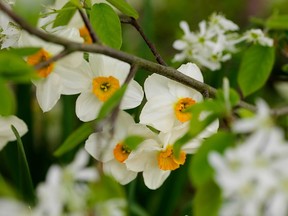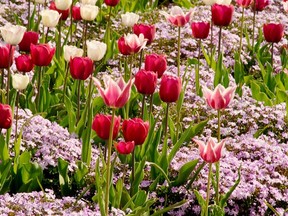Your bulbs will improve every year as the bulbs perennialize and expand their show
Published Sep 08, 2024 • Last updated 0 minutes ago • 5 minute read

It’s the only time of the year you can plant bulbs that will flower in fall, winter, spring and summer and what a wonderful opportunity to plan a repeat garden performance for each season, which will improve every year as the bulbs perennialize and expand their show.
In just a few weeks the autumn crocus, or colchicums, will pop out of the ground, provide fresh new colour for your late summer garden, and then disappear until their foliage emerges in April to help grow new bulbs for the next year.
Advertisement 2
THIS CONTENT IS RESERVED FOR SUBSCRIBERS ONLY
Subscribe now to read the latest news in your city and across Canada.
- Unlimited online access to articles from across Canada with one account.
- Get exclusive access to the Vancouver Sun ePaper, an electronic replica of the print edition that you can share, download and comment on.
- Enjoy insights and behind-the-scenes analysis from our award-winning journalists.
- Support local journalists and the next generation of journalists.
- Daily puzzles including the New York Times Crossword.
SUBSCRIBE TO UNLOCK MORE ARTICLES
Subscribe now to read the latest news in your city and across Canada.
- Unlimited online access to articles from across Canada with one account.
- Get exclusive access to the Vancouver Sun ePaper, an electronic replica of the print edition that you can share, download and comment on.
- Enjoy insights and behind-the-scenes analysis from our award-winning journalists.
- Support local journalists and the next generation of journalists.
- Daily puzzles including the New York Times Crossword.
REGISTER / SIGN IN TO UNLOCK MORE ARTICLES
Create an account or sign in to continue with your reading experience.
- Access articles from across Canada with one account.
- Share your thoughts and join the conversation in the comments.
- Enjoy additional articles per month.
- Get email updates from your favourite authors.
Sign In or Create an Account
or
Article content
Native mainly to Asia Minor and the eastern Mediterranean, these autumn crocus also have been found in much of Europe and even Britain. There are over fifty species of colchicums, but the fall blooming beauties here are colchicum autumnale. It’s the most prolific single flowering variety, lavender in colour, and grows to about five inches, with the new corms often producing three to five flowers. They naturalize early and in a few short years will become a solid colourful ground cover.

Also usually available now are the single flowering white, c. Album, as well as a beautiful double white, c. autumnale album plenum. Another very popular variety is c. autumnale Water Lily, which is a quite spectacular fully double lavender pink.
The often unexpected and sudden colour they bring to our late summer gardens is always refreshing, and they make a great underplanting to rhododendrons, standard hydrangeas and small trees.
The more sought-after and well-known fall bloomers are the Saffron Crocus, or crocus sativus. Historically used as a dye, its true value is the spice, saffron, which is produced by its stigmas. If you were thinking of growing your own, it takes about 4000 flowers to yield one ounce of saffron! Apart from its value as a spice, its beautiful lilac-purple flowers, with their extra-large red orange stigmas, are very striking.
By signing up you consent to receive the above newsletter from Postmedia Network Inc.
Article content
Advertisement 3
Article content
There are many other fall blooming crocuses, like the violet blue c. speciosus, as well, but usually only a few are available in garden stores this time of year.

Galanthus nivalis, known as the common snowdrop, is one of the easiest to grow and one of the most prolific multipliers, in our gardens. It’s important to plant them as soon as we are able in September so they can become well rooted and provide some of the first colour in the New Year. They prefer a sunny location and well drained soil with some humous materials mixed in. Plant them two to three inches deep and about four to five inches apart.
There are many varieties of galanthus, but all prefer to be left in one location to naturalize more quickly. Snowdrops do well in lawns as well as being the perfect underplanting beneath rhodos, early flowering shrubs and small trees.
Winter aconites look like miniature buttercups and become a beautiful yellow ground cover. They are happiest in a slightly shaded location and make a welcome splash of early colour while the snowdrops are still in bloom. Well drained soils are a must and they, too, like to be left alone to naturalize and expand their territory.
Advertisement 4
Article content

Spring flowering crocus should be planted as soon as possible now, too, to get them established for their early show. The first to bloom are the Snow Crocus, c. chyrsanthus, which have smaller flowers with beautiful markings and a delicate scent. They usually begin flowering in February, providing the first really vibrant colour in our winter gardens. The larger flowered c. vernus, or Dutch crocus, flower about two weeks later in March and put on a good show. Both varieties will naturalize well and multiply over the years for an even more spectacular display each winter and spring.
Crocus are also great companion plantings under small trees and shrubs. I particularly like pairing them with winter flowering heather and compact, early blooming rhododendrons and azaleas. There is a golden evergreen low-growing sedum called Angelina which is a perfect home, especially for the bright blues, purples and stripes of your crocus.

Narcissus have an exceptionally long blooming period if you choose your varieties carefully. The Vancouver Parks Department made quite a promotion a few years back with daffodils blooming along the beach in Stanley Park in February. N. rynveld Early Sensation can bloom as early as January, depending upon the type of winter weather we get. The later blooming fragrant narcissus, n. Geranium, n. actea and n. Cheerfulness are usually the last to bloom in mid-May.
Advertisement 5
Article content
If you only have a small space, the many varieties of miniature narcissus like n. February Gold, n. bulbocodium, and everyone’s favourite, n. Tête à tête, are perfect for compact gardens.
Tulips, as well, have a very long blooming period from late February well into May. From the earliest botanicals to the late double blooming peony flowered varieties, you can enjoy over three months of colour.
Alliums are the last to bloom, usually from June until July. There are so many spectacular varieties, all of which naturalize nicely, but it’s the giant alliums which get the most attention. Allium giganteum and a. Globemaster are the garden giants with flower heads from six to eight inches across. I love a. Cristophii and a. Schubertii, whose flowers look like a purple shooting star.
These are just a few of the bulbs you can plant now and enjoy over almost a full year. If you’re keen on having twelve months of colour there are also lots of species bulbs like cyclamen coum and c. hederifolium that will nicely fill in any gaps. The opportunity is now. Bulbs are just arriving at many garden stores and you can strategically plan and plant a long-term symphony of colour.
Advertisement 6
Article content
Recommended from Editorial
-

Brian Minter: Backyard escapes trending as plants and flowers tweaked for climate change
-

Brian Minter: Summer pruning requires an aggressive touch
Bookmark our website and support our journalism: Don’t miss the news you need to know — add VancouverSun.com and TheProvince.com to your bookmarks and sign up for our newsletters here.
You can also support our journalism by becoming a digital subscriber: For just $14 a month, you can get unlimited access to The Vancouver Sun, The Province, National Post and 13 other Canadian news sites. Support us by subscribing today: The Vancouver Sun | The Province.
Article content
.png)
 1 week ago
12
1 week ago
12




































 Bengali (BD) ·
Bengali (BD) ·  English (US) ·
English (US) ·